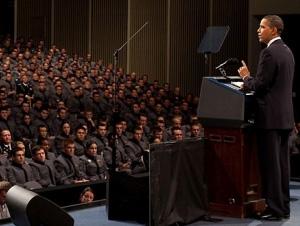The new plan for Afghanistan
President Obama speaking at West Point. (Image: whitehouse.gov)
The following is a partial transcript; for full story, listen to audio
In a speech at West Point last night, President Obama announced he will send 30,000 more troops to Afghanistan starting early next year. His rhetoric focused on both domestic and global security.
“America, we are passing through a time of great trial,” said the President. “The message that we send in the midst of these storms must be clear: That our cause is just, our resolve unwavering. We will go forward with the confidence that right makes might, with a commitment to forge an America that is safer, a world that is more secure, and a future that represents not the deepest of fears, but the highest of hopes.”
He balanced his announcement of a troop buildup with a pledge to begin withdrawing American forces in 18 months. The President said the new policy is designed to bring the war in Afghanistan to a successful conclusion, and he said the first new US forces will be on the ground by Christmas.
President Obama also stressed the importance of handing power over to local authorities: “It must be clear that Afghans will have to take responsibility for the security, and that America has no interest in fighting an endless war in Afghanistan.”
Clare Lockhart, co-founder of the Institute of State Effectiveness, says the new strategy makes sense, based on General Stanley McChrystal’s assessment over the summer of the deterioration in security and weakness in governance in Afghanistan, which allowed for the Taliban to return.
“What was needed in effect is a security bridge,” said Lockhart. “The Afghan forces can’t take care of security in their own country, so the additional forces are going to provide that security bridge. But the real focus is going to be on two things: protecting the population in the meantime, and training up the Afghan national security forces.”
Once Afghan security forces are able to take over, the US will begin an exit strategy that President Obama says he hopes to start in July, 2011.
Michael Gordon, military correspondent for “The New York Times,” believes the timeline is really intended for the American public. This is a risk, he says, because for the Afghan public, this may not be what they need to hear.
“The notion of beginning the withdrawal in July 2011 — although they don’t say how long it would take or how quickly it would be carried out — it’s really aimed at the American public opinion. It’s intended to really shore up, I think, his Democratic base and convey that the war’s not open-ended.
“The risk is that people in Afghanistan might read this as an indication that the Americans are only there for a short period.”
“The Takeaway” is a national morning news program, delivering the news and analysis you need to catch up, start your day, and prepare for what’s ahead. The show is a co-production of WNYC and PRI, in editorial collaboration with the BBC, The New York Times Radio, and WGBH.
